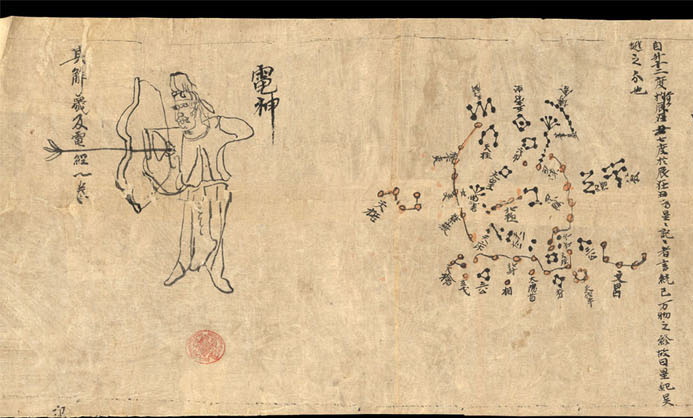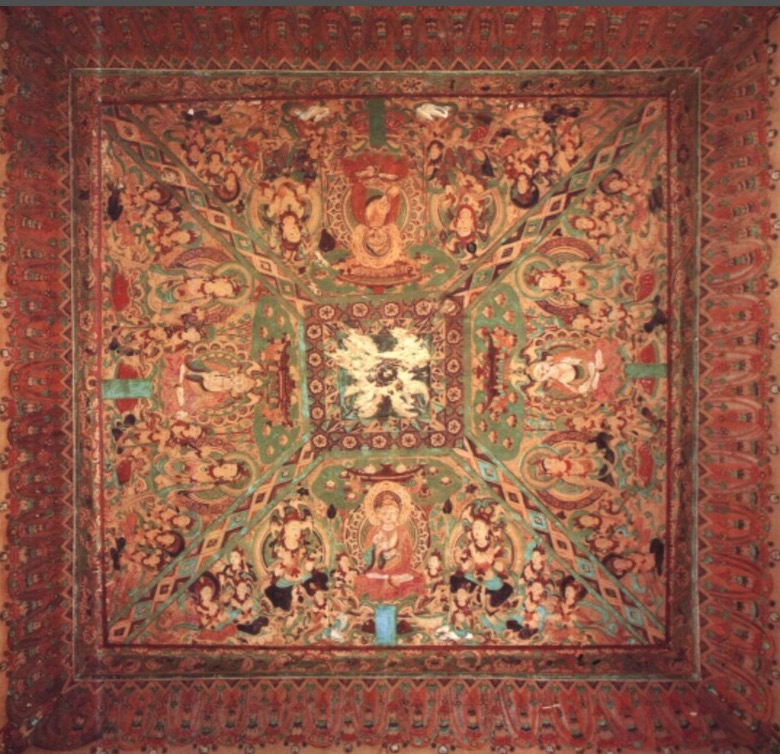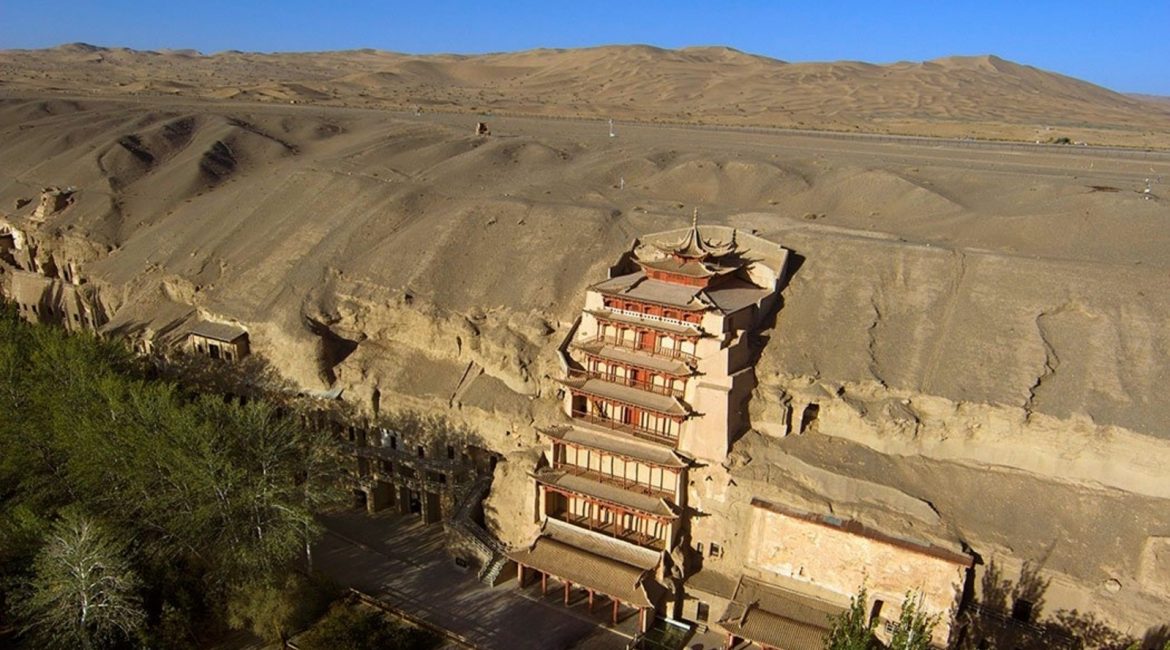The site of the Mogao Grottoes holds a special place in the hearts of not only the Chinese people, but also generations of dedicated researchers across disciplines. It is the representative hub of multicultural encounters (Sino-Tibetan, Sino-Sogdian, and even Indo-Tibetan) at the periphery of the classical-medieval Chinese world. Certain textual and material findings hint at a vast world of knowledge and practice that we still know little about.
For example, the star atlas included in the medieval Chinese manuscript of Or.8210/S.3326, found at Dunhuang, is the oldest one from any civilization known today (around 700 CE). Why this star chart was made, and with such astronomical expertise, is not clear. But it is speculated in a comprehensive analysis about this star chart (by Dr. Susan Whitfield, Dr. Françoise Praderie, and astrophysicist Jean-March Bonnet-Bidaud) that S.3326 would have been stored in the famous Library Cave, which functioned doubly as a Buddhist library and as a repository of documents from the Chinese administrative archive (IDP). It might have been copied in Dunhuang, or originally produced at the Imperial Observatory and brought to Dunhuang. This likely would have happened specifically during the period of Tibetan administration from 787–848.
This brief spell of colonization in a usually Chinese-ruled region led to important developments that reshaped the Sino-Tibetan mutual influence in Buddhism. Appearing at the center of the caisson ceilings of certain caves are the visvavajra, a motif of two intercrossed vajras. They chronologically first appear in the middle Tang period in Cave 361, and in the late Tang in Cave 14. This pairing means much more than simply a traditional vajra, times two. An expert we consulted on this iconography before travelling to Dunhuang, Xi’an, and Luoyang was young scholar Dr. Shella Li Shen.

Shella obtained her doctorate at Chinese University of Hong Kong and is currently a postdoctoral fellow at the Hong Kong Polytechnic University (PolyU). Having started off as a scholar of Tibetan texts, she gradually moved into Buddhist Studies due to Tibetan language’s proximity to Buddhist texts. She is an interdisciplinary scholar who believes that visual analysis and art history can complement philology and textual analysis. Her goal is to examine art and iconography and, in turn, the tantric principles informing their production.
Our discussion covered the visvavajra, the Huayan tradition, and even the Tangut Empire: all subjects that lie at the thematic crossroads of Sino-Tibetan esotericism. “These caves were built when the Tibetans occupied Dunhuang, and it is clear that they were inspired by Chinese esoteric tantra (zhenyan; tangmi),” says Shella. “In my research, which will be published in a forthcoming paper, I argue that this visvavajra of the caisson ceilings represent the homa mandala. The homa ritual has always been a central feature of esoteric Buddhism, but the caves of Mogao are notoriously small. Therefore, the visvavajra was painted on the ceiling so that the fire ritual could be visualized.”
In his book detailing the rise of mandala practice in China, Koichi Shinohara describes how the earliest mandala initiations in China began in the 6th and 8th centuries with the Divine Spell of Eleven-faced Avalokiteshvara, which is not only preserved in different translations by by Xuanzang (c. 600–664) and Amoghavajra (705–774) but also partly preserved in the Tibetan Gilgit manuscripts. The instructions are comprehensive, laying out how to carve a wooden image of the deity, lay out the ritual space that is the mandala, and contemplate (guannian; 觀念) a full moon emitting light in ten directions from his chest. While bathed in this light, he recites a mantra with his body merging with Avalokiteshvara. A physical image is also placed in the centre of the mandala and given offerings.

The difference between this early description of an Avalokiteshvara mandala and the visvavajra mandalas of the Dunhuang caisson ceilings is that the latter represent Vairocana, the esoteric Great Sun Buddha that appears not only in imperially sanctioned texts of the Yarlung dynasty of Tibet like the Mahavairocana tantra, but also in the Huayan jing. “The Vairocana visvavajra of Cave 14 represent, at least partially, the Vairocana found in the Mahavairocana tantra. The ceiling art of the caves helped to visually represent a very initial form of the Five Dhyani Buddha mandala that first appeared in Tibet in the 10th century,” says Shella. “But we need to keep in mind that the motif is constantly in development. According to different mandalas and contexts, the visvavajra can appear as representing different deities.”
While Cave 361 is not open to the public, Cave 14 is. Shella shared an image of 14’s caisson ceiling, where the visvavajra dwells. “We can see how esoteric Buddhism should not be separated so clearly between Chinese and Tibetan tantra,” she says. “At least for a few centuries, the art history attests to mutual influence exerted by both ‘camps’ even though Vajrayana is a further evolution of Mahayana Buddhism.”
The Western Xia or Xixia, was a powerful desert empire that was established by the Tangut people, descendants of the Tuoba people, who in turn belonged to the Qiang ethnic group. The Tangut Empire was therefore a geopolitical meeting point or link between Tibetan Vajrayana and Chinese esotericism. The Tangut presence is strongly felt at the Yuling Grottoes. “At Yulin, Caves 2, 3, 4, and 10 are Tangut tantric caves. The emperors of Xixia invited both Chinese and Tibetans to court and formed their own esoteric Buddhist canon,” notes Shella.
The Tanguts engaged in a high-stakes geopolitical struggle between the Liao, Song, and Jin empires that ended with the unexpected and terrifying eruption of Mongol power and violence in the form of Genghis Khan and his armies. The Mongols wiped out the Xixia in 1227, breaking the Sino-Tibetan esoteric connection. The Yuan wielded overlordship over Tibet from 1244–1354, and Kublai Khan’s (1215–94) conversion to Tibetan Buddhism—specifically, the Sakya school and Khön aristocratic family, to the point that 14 leaders held the title of imperial preceptor before the Yuan’s collapse—meant that Tibetan tantra was privileged over Chinese expressions of esotericism.

This privileging, however, only meant a retreat from Chinese esoteric Buddhism from the public consciousness, even as its living lineage consolidated itself in Japan thanks to the efforts of Kukai (774–835). Buddhism could only have survived in China thanks to the emperor’s favor and the state’s support. And from the outset, foreign translators and Chinese imperial compilers did not distinguish between sutra and tantra. “We rarely think about it, given its everyday ubiquity, but the Heart Sutra and the practice of nianfo, Namo Amitabha, are actually tantric. Or at the very least, I am trying to demonstrate that these categories of tantric, Vajrayana, Mahayana, and so on overlap so often and so profoundly that they are not actually that helpful, and can even obscure a richer understanding of Buddhism’s harmony.” She suggests that next time one sees a Chinese text, it would be helpful to see where “tuoluoni” (dharani) is mentioned in the text. Its appearance might be more frequent than expected.
Shella believes that in a Buddhist context, it is not exaggeration to talk about a “Sino-Tibetan” unity. “Most Tibetans speak Putonghua and many Han scholars embrace the need to read Tibetan. From my fieldwork and personal interactions, I think both sides want to keep the other in their sphere of knowledge.” Sino-Tibetan relations have moved on from the ancient patron-client relationship and instead, scholars and laypeople alike are seeking to break down distinctions and artificial divides.
In “real” Buddhism, the Vajrayana and Mahayana are one vehicle. “My message is simple: give Chinese tantra a closer look. You might be surprised.”
Reference
Koichi Shinohara. 2014. Spells, Images, and Maṇḍalas: Tracing the Evolution of Esoteric Buddhist Rituals. New York: Columbia University Press.
See more
THE DUNHUANG CHINESE SKY: A COMPREHENSIVE STUDY OF THE OLDEST KNOWN STAR ATLAS
How Xuanzang Saw Dhāraṇī
Related blog posts from BDG
From the Capitals to the Corridor: A Visit to China’s Silk Road
Yarlung Rising: The Imperial Cult of the Sun Buddha, with Dr. Giorgios Halkias


